
12 Ways To Make Any Recipe (especially Kitchari) AMAZING!!
1. Use Fresh Spices
Spices are a kitchari essential and if you are using stale, old, lifeless spices that have been sitting in your cabinet for over a year, well your kitchari may just taste lifeless too. By using fresh spices, you will be able to smell, taste, and feel the difference in ANY kitchari recipe…. and don’t be shy. Kitchari should be a beautiful golden color with specs of browns and blacks. If your kitchari is a pale yellow, you may need to add another dash of turmeric to your pot!
Spices are a kitchari essential and if you are using stale, old, lifeless spices that have been sitting in your cabinet for over a year, well your kitchari may just taste lifeless too. By using fresh spices, you will be able to smell, taste, and feel the difference in ANY kitchari recipe…. and don’t be shy. Kitchari should be a beautiful golden color with specs of browns and blacks. If your kitchari is a pale yellow, you may need to add another dash of turmeric to your pot!
Freshness tip: Try to make sure your powdered spices are less than 6 to 9 months old, your whole spices are less than a year old, and they are stored in an airtight glass jar out of the sunlight.
2. Sauté the spices before Cooking
Please do not simply add your spices into your already made kitchari! By taking a moment to sauté them in a small amount of ghee, oil or dry before the cooking process, you will undoubtedly enhance the flavor and aroma of your meal. In fact, your whole house will smell of delicious spice, your mouth will begin to water, and your digestive fire will be awakened!
Please do not simply add your spices into your already made kitchari! By taking a moment to sauté them in a small amount of ghee, oil or dry before the cooking process, you will undoubtedly enhance the flavor and aroma of your meal. In fact, your whole house will smell of delicious spice, your mouth will begin to water, and your digestive fire will be awakened!
Sauté tip: Sauté any whole seeds in the hot oil for about 2 minutes stirring frequently (they should begin to pop or crackle when done). The powdered spices will burn more quickly and should be only sautéed for 30 to 60 seconds, stirring constantly. This process should be done as the first step to your recipe and then the water can be added directly to the same pot after the spices (and onion, etc) have been sautéed.
3. Use Fresh ginger and freshly ground black pepper
Replacing your powdered ginger with finely minced fresh ginger will give any kitchari recipe more life and zing! Freshly ground black peppercorns will provide much more flavor. Although dry ginger will still bestow many health benefits, many people’s pre-ground black pepper tends to be very old, dull, grey, and yes, lifeless. Black pepper has so much flavor and so many health properties, but to really utilize them, we must think fresh!
Replacing your powdered ginger with finely minced fresh ginger will give any kitchari recipe more life and zing! Freshly ground black peppercorns will provide much more flavor. Although dry ginger will still bestow many health benefits, many people’s pre-ground black pepper tends to be very old, dull, grey, and yes, lifeless. Black pepper has so much flavor and so many health properties, but to really utilize them, we must think fresh!
4. Keep it exciting – switch up the ingredients!
Kitchari traditionally consists of mung dal, basmati rice, ghee, and spices. This is a great basic base, but if you plan to eat kitchari regularly, this will simply not do. I make kitchari using whole mung beans, red lentils, mung dal, or chana dal depending on my day’s preference. I also may use red rice, brown rice, quinoa, millet, or basmati for the grain. And when it comes to vegetables, the possibilities are quite vast – carrots, beets, bitter greens, spinach, broccoli, cauliflower, zucchini, sweet potato. . . OH MY! Even the choice of spices can greatly change the flavor. Get creative!
By choosing these various ingredients, you can change the flavor, the energetics (heavy, light, heating, cooling, etc), and even the healing properties of any kitchari recipe!
Kitchari traditionally consists of mung dal, basmati rice, ghee, and spices. This is a great basic base, but if you plan to eat kitchari regularly, this will simply not do. I make kitchari using whole mung beans, red lentils, mung dal, or chana dal depending on my day’s preference. I also may use red rice, brown rice, quinoa, millet, or basmati for the grain. And when it comes to vegetables, the possibilities are quite vast – carrots, beets, bitter greens, spinach, broccoli, cauliflower, zucchini, sweet potato. . . OH MY! Even the choice of spices can greatly change the flavor. Get creative!
By choosing these various ingredients, you can change the flavor, the energetics (heavy, light, heating, cooling, etc), and even the healing properties of any kitchari recipe!
5. Keep it healing – Focus on Health
Whether you are looking to calm your Vata, lose weight, strengthen your bones, or cleanse your liver, there is a kitchari recipe out there for you! You would want to use more heavy and nourishing kitchari ingredients such as basmati rice, sweet potato, and beets if your Vata is high, while focusing more on stimulating and lightening ingredients such as quinoa, onion, garlic, chili pepper, and bitter greens during times of weight loss. Similarly you will want to add in some calcium-rich ingredients for improving bone health (think sesame seeds, broccoli, leafy greens), and some liver-healing foods for liver cleansing (think bitter greens, fresh lemon juice, red rice, and olive oil). No matter your healthcare needs, adding in or switching up your typical kitchari ingredients will give you more variety and more focused healing!
Whether you are looking to calm your Vata, lose weight, strengthen your bones, or cleanse your liver, there is a kitchari recipe out there for you! You would want to use more heavy and nourishing kitchari ingredients such as basmati rice, sweet potato, and beets if your Vata is high, while focusing more on stimulating and lightening ingredients such as quinoa, onion, garlic, chili pepper, and bitter greens during times of weight loss. Similarly you will want to add in some calcium-rich ingredients for improving bone health (think sesame seeds, broccoli, leafy greens), and some liver-healing foods for liver cleansing (think bitter greens, fresh lemon juice, red rice, and olive oil). No matter your healthcare needs, adding in or switching up your typical kitchari ingredients will give you more variety and more focused healing!
6. Keep it Seasonal
Focus on season. Keeping your kitchari ingredients seasonal, will allow more variety of flavor throughout the year, while also providing you with the freshest, most nutrient-rich, and environmentally friendly ingredients.Not to mention mother nature is oh-so-wise and these seasonal vegetables will help to keep you in balance – no matter the time of year! Sweet potato, beets, carrots, and winter squash are in season during fall and winter and will help to keep you grounded and warm. Zucchini, yellow squash, asparagus, broccoli, and cauliflower are freshest in the spring and summer seasons and will keep you cool and hydrated.
7. Use Tasty Condiments
When it comes to kitchari, there are so many scrumptious additions to add to your dish. Each condiment will bring its own unique flavor – and health benefits too! The list is really endless but my absolute favorites are a spicy chutney (or any chutney you desire), shredded coconut, toasted sesame seeds, a scoop of tahini, chopped cilantro, fresh lemon or lime juice, and/or toasted almond slivers or cashew pieces.
As you can imagine, each condiment will add its specific qualities. For example, adding a scoop of yummy tahini to a bowl of kitchari will instantly give it some creaminess, bulkiness, warmth, and a delicious sesame seed flavor; whereas adding in some chopped cilantro will increase the cooling, cleansing properties of the meal and provide its own uniquely, delicious flavor. Mix and match and see (or rather taste) the possibilities as they unfold!
Focus on season. Keeping your kitchari ingredients seasonal, will allow more variety of flavor throughout the year, while also providing you with the freshest, most nutrient-rich, and environmentally friendly ingredients.Not to mention mother nature is oh-so-wise and these seasonal vegetables will help to keep you in balance – no matter the time of year! Sweet potato, beets, carrots, and winter squash are in season during fall and winter and will help to keep you grounded and warm. Zucchini, yellow squash, asparagus, broccoli, and cauliflower are freshest in the spring and summer seasons and will keep you cool and hydrated.
7. Use Tasty Condiments
When it comes to kitchari, there are so many scrumptious additions to add to your dish. Each condiment will bring its own unique flavor – and health benefits too! The list is really endless but my absolute favorites are a spicy chutney (or any chutney you desire), shredded coconut, toasted sesame seeds, a scoop of tahini, chopped cilantro, fresh lemon or lime juice, and/or toasted almond slivers or cashew pieces.
As you can imagine, each condiment will add its specific qualities. For example, adding a scoop of yummy tahini to a bowl of kitchari will instantly give it some creaminess, bulkiness, warmth, and a delicious sesame seed flavor; whereas adding in some chopped cilantro will increase the cooling, cleansing properties of the meal and provide its own uniquely, delicious flavor. Mix and match and see (or rather taste) the possibilities as they unfold!
8. Add some Ghee to your Bowl!
Whether you have used ghee to cook your kitchari with or not, I highly recommend adding a bit extra to your bowl upon serving. Adding in 1/2 to 1 teaspoon of ghee (per bowl) to your kitchari, directly before you are ready to take your first bite, will give your meal a very delicious flavor that will stand out! In the cooking process the taste gets lost, so if you like add a little more and enjoy!
Whether you have used ghee to cook your kitchari with or not, I highly recommend adding a bit extra to your bowl upon serving. Adding in 1/2 to 1 teaspoon of ghee (per bowl) to your kitchari, directly before you are ready to take your first bite, will give your meal a very delicious flavor that will stand out! In the cooking process the taste gets lost, so if you like add a little more and enjoy!
9. Use Broth as a Base
If you really want to yummy up your kitchari recipe, this recommendation will not disappoint!Replacing the water in any kitchari recipe with a broth of choice (bone, chicken, veggie, etc – homemade is best), will give a delicious flavor and yes, more health benefits!This recommendation is great during the fall and winter months when you are needing a bit more nutrition, healing, and warmth. It is also great during times of illness, Vata imbalance, and when you are coming off of a cleanse. Of course, I use broth anytime I simply want to add a delicious flavor and some excitement to my everyday kitchari meals.
If you really want to yummy up your kitchari recipe, this recommendation will not disappoint!Replacing the water in any kitchari recipe with a broth of choice (bone, chicken, veggie, etc – homemade is best), will give a delicious flavor and yes, more health benefits!This recommendation is great during the fall and winter months when you are needing a bit more nutrition, healing, and warmth. It is also great during times of illness, Vata imbalance, and when you are coming off of a cleanse. Of course, I use broth anytime I simply want to add a delicious flavor and some excitement to my everyday kitchari meals.
10. Share the Love, Eat in good company, and always be grateful!
Keeping to this recommendation can make any meal more enjoyable (and healing).It is always best to share your meals and when they are cooked by you, it makes it all the more special! If no one in your house wants your kitchari (sadly I can relate), then the next best thing is to sit, eat, and enjoy your meal in good company and good (light) conversation. If you are alone in your home, well then sit, breath in the aroma, enjoy the silence around you, and give thanks and blessings for your delicious meal!
11. Reheat the Right way
Reheating meals is not recommended for those who are trying to strengthen their digestion.. However, reheating is a reality for many of us (including myself!), and I personally believe that reheating a home cooked meal, making a frozen meal, or eating processed pre-made food is still a healthier option instead of eating out. So, if you have made a large pot of kitchari to eat for the next couple of days, here are some essential tips to reheating the right way!
Keeping to this recommendation can make any meal more enjoyable (and healing).It is always best to share your meals and when they are cooked by you, it makes it all the more special! If no one in your house wants your kitchari (sadly I can relate), then the next best thing is to sit, eat, and enjoy your meal in good company and good (light) conversation. If you are alone in your home, well then sit, breath in the aroma, enjoy the silence around you, and give thanks and blessings for your delicious meal!
11. Reheat the Right way
Reheating meals is not recommended for those who are trying to strengthen their digestion.. However, reheating is a reality for many of us (including myself!), and I personally believe that reheating a home cooked meal, making a frozen meal, or eating processed pre-made food is still a healthier option instead of eating out. So, if you have made a large pot of kitchari to eat for the next couple of days, here are some essential tips to reheating the right way!
- Use a stove top and always avoid microwaves
- Heat slow and evenly stirring often
- Only reheat what you need – never reheat any food more than once!
- Use turmeric and fresh lemon (or lime) juice in your original kitchari recipe to help preserve the kitchari (and its health benefits!)
- Kitchari tends to dry out when refrigerated – add in 1/4 cup of water or broth to make it moist again (if needed)
- Add a small amount of fresh spices (e.g. turmeric, ginger, black pepper, cayenne pepper, salt) when reheating your meal to awaken the flavor
- Add fresh ghee and condiments (cilantro, lemon juice, etc) after reheating each serving
- Store the extra kitchari in an airtight glass container
- Eat within 1 to 2 days
12. Cut Vegetables fresh for each batch
I have learned that once metal cuts through vegetables, they begin to oxidize and lose prana & vitality. Therefore, if you can and it's practical chop your vegetables while kitchari is cooking.
I have learned that once metal cuts through vegetables, they begin to oxidize and lose prana & vitality. Therefore, if you can and it's practical chop your vegetables while kitchari is cooking.
Kitchari Ingredients
Mung dal
Mung dal is the split version of the mung bean and is used in any traditional kitchari recipe for its high nutrient content and easy-to-digest nature. This recipe utilizes an exaggerated amount of liquid making the mung dal even more digestible and easy on the stomach. If mung dal is not available, one can replace this with an equal amount of split red lentils.
Mung dal is the split version of the mung bean and is used in any traditional kitchari recipe for its high nutrient content and easy-to-digest nature. This recipe utilizes an exaggerated amount of liquid making the mung dal even more digestible and easy on the stomach. If mung dal is not available, one can replace this with an equal amount of split red lentils.
Basmati rice
Basmati rice is a kitchari essential due to its soft nature and easy-to-digest properties. Eating the basmati rice along with the mung dal creates a “perfect protein” meaning it provides all of the 9 essential amino acids. If basmati rice is not preferred, one can replace this with an equal amount of long grain white rice or white quinoa.
Basmati rice is a kitchari essential due to its soft nature and easy-to-digest properties. Eating the basmati rice along with the mung dal creates a “perfect protein” meaning it provides all of the 9 essential amino acids. If basmati rice is not preferred, one can replace this with an equal amount of long grain white rice or white quinoa.
Fresh lemon or lime juice
Fresh lemon juice is used to add a touch of immune boosting vitamin C while simultaneously aiding in the flushing of toxins and providing us with essential digestive enzymes.
Fresh lemon juice is used to add a touch of immune boosting vitamin C while simultaneously aiding in the flushing of toxins and providing us with essential digestive enzymes.
Fresh ginger
Fresh ginger is unparalleled in its ability to heal during times of illness. Some of its major health benefits include boosting the digestion and immunity, detoxifying the system, relieving nausea, promoting sweating and alleviating fever.
Fresh ginger is unparalleled in its ability to heal during times of illness. Some of its major health benefits include boosting the digestion and immunity, detoxifying the system, relieving nausea, promoting sweating and alleviating fever.
Spices (black pepper, turmeric, cumin, fennel, brown mustard seed)
These spices have been carefully chosen as they all are well known for their digestive enhancing properties. Utilizing these spices during illness will aid in flushing the system, killing off unwanted bacteria and viruses, promoting sweating and reducing fever.
These spices have been carefully chosen as they all are well known for their digestive enhancing properties. Utilizing these spices during illness will aid in flushing the system, killing off unwanted bacteria and viruses, promoting sweating and reducing fever.
Ghee
Ghee is another kitchari essential as it is known to boost the digestive fire, promote healthy elimination and increase our vital immunity and energy (Ojas).
Ghee is another kitchari essential as it is known to boost the digestive fire, promote healthy elimination and increase our vital immunity and energy (Ojas).
Garlic
When used properly, this heating vegetables is very effective at stimulating the digestive fire and detoxifying the system. Garlic is a potent immune-boosting, antimicrobial agent and is very beneficial for the system during times of illness (in moderation).
When used properly, this heating vegetables is very effective at stimulating the digestive fire and detoxifying the system. Garlic is a potent immune-boosting, antimicrobial agent and is very beneficial for the system during times of illness (in moderation).
Green onion
Green onion has been added to help spark the digestion, add a bit of flavor and provide us with some much needed vitamins (spec A, C, K). Studies have shown this tasty condiment to enhance immune function.
Green onion has been added to help spark the digestion, add a bit of flavor and provide us with some much needed vitamins (spec A, C, K). Studies have shown this tasty condiment to enhance immune function.
There are many kitchari variations listed under the Easy & Delicious Recipe category of my blog and for detailed instructions on how I cook Kitchari, please see The Art of Cooking Kitchari.
I hope this was insightful and I would love to hear from you with any comments or questions! :) If you would like any support towards your health goals, I would love to set up a consultation. Learn more about consultations here.
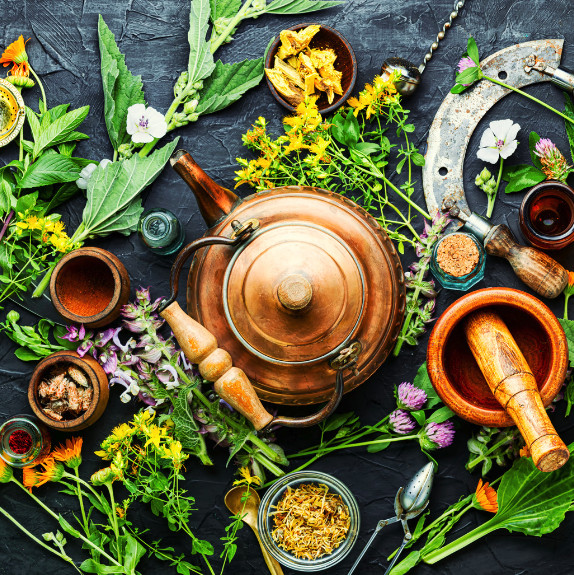
Ayurveda, the ancient holistic healing system from India, categorizes body constitutions into three primary doshas: Vata, Pitta, and Kapha. Each individual typically has a dominant dosha or combination of doshas that define their physical and mental characteristics. Balancing these doshas is crucial for maintaining health and well-being.
Ayurvedic Healing Bone Broth
Bone broth is considered tridoshic because it can benefit all three doshas—Vata, Pitta, and Kapha—when prepared and consumed appropriately. Here’s how it can be beneficial for each dosha:
Vata Balancing
Attributes: Vata is characterized by qualities like coldness, dryness, and lightness.
Bone Broth Benefits: The warming and nourishing nature of bone broth helps to counterbalance Vata's cold and dry qualities. Its rich, grounding nature can help soothe and stabilize Vata energy, making it beneficial for individuals with Vata imbalances such as anxiety, insomnia, and digestive issues. Adding warming spices like ginger or black pepper enhances its Vata-pacifying properties.
Pitta Balancing
Attributes: Pitta is associated with heat, intensity, and fluidity.
Bone Broth Benefits: Although bone broth is generally warming, it can be adapted to suit Pitta by ensuring it's not too spicy or overly heated when served. The cooling and hydrating qualities of well-strained broth can help ease inflammation and digestive discomfort typical in Pitta imbalances. Incorporating cooling herbs like coriander or cilantro can make it more suitable for Pitta individuals.
Kapha Balancing
Attributes: Kapha is known for its moist, heavy, and stable qualities.
Bone Broth Benefits: To address Kapha imbalances, which often involve congestion and sluggishness, bone broth can be made lighter and more stimulating. The light and easily digestible nature of bone broth helps to alleviate Kapha's heaviness. Adding pungent and warming spices like turmeric or cayenne pepper can further enhance its Kapha-pacifying effects.
Nutritional Profile
Bone broth is celebrated for its rich content of essential nutrients such as collagen, gelatin, and minerals like calcium, magnesium, and phosphorus. It also contains fat-soluble vitamins, which are crucial for bone health and overall vitality. The easily digestible form of these nutrients ensures that they are readily absorbed and utilized by the body, making bone broth a powerful ally in supporting joint health, skin elasticity, and gut integrity across all dosha types.
By customizing the preparation of bone broth to suit individual dosha needs, it can serve as a versatile and nourishing staple in an Ayurvedic diet, helping to promote balance and well-being. Always tailor the herbs and spices to address specific doshic attributes or imbalances for the best results.
Here is an idea for a recipe for Ayurvedic Bone Broth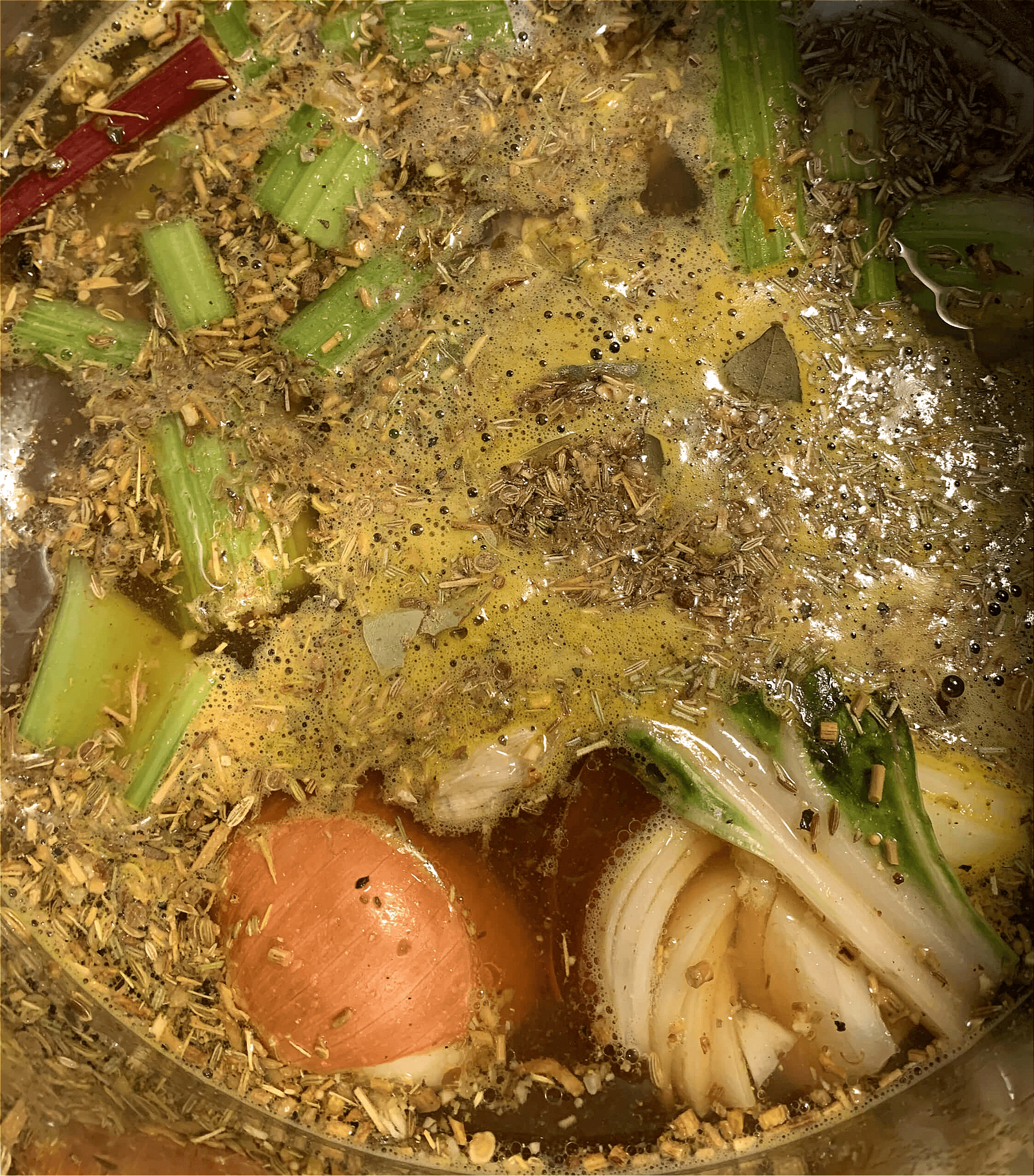

Ingredients
10 cups purified water
4 “bone marrow” beef bones (available in whole foods or most meat departments)
1 pound of chicken breast or beef stew meat (optional, but recommended for flavor)
2 carrots, sliced
2 celery sticks, sliced
1 small to medium beet, chopped (replace with sweet potato for Pitta)
1/2 onion, chopped
Fresh ginger (2 inch cube), grated or finely chopped
1/4 teaspoon each of turmeric, fennel, coriander, fenugreek, brown mustard, and cumin seed*
1/4 teaspoon black peppercorns, freshly ground
1 lemon, juiced
1/4 teaspoon pink salt, mineral salt, or sea salt
*Optional to add 1 Tbl Astragalus, Burdock Root, and/or Licorice Root for additional immune and liver support
Healing Bone Broth Recipe
1. Add the bones, chopped veggies, fresh ginger, turmeric, fennel, coriander, fenugreek, brown mustard, cumin seed, and black pepper to the crock pot. If meat is being used, add this now as well.
2. Fill the crock pot with water until it is 2 to 3 inches from the top.
3. Cover the pot and turn it on a low setting. Cook for 10 to 16 hours. If needed a high setting can be used for 6 to 8 hours.
Optional Doshic Variations
Vata
This recipe is very beneficial for Vata types and is great during times of Vata imbalances such as depletion, weakness, constipation, osteoporosis, and arthritis. If there is anemia, it is recommended to use a red meat to steep with the bones. Otherwise, no changes are needed!
Pitta
Pitta types can replace the beets and onion with more cooling root veggies such as sweet potatoes and parsnips. They should replace the lemon with lime and add in fresh cilantro leaves (about 1/2 cup). Pitta types should avoid adding any red meat to the base. White meat chicken would be a better option if meat is to be added. Otherwise, this recipe is very beneficial for Pitta and an effective way to reduce inflammation in the body.
Kapha
To enhance digestion, they can add in extra heating spices such as cayenne pepper. They can also add in chopped garlic cloves, chili pepper and/or a splash of apple cider vinegar if desired. The salt should be kept to a minimum, ideally using pink Himalayan which is best for Kapha types. This is a great option for Kapha types as a healthy and light snack between meals!
Perhaps you dont want to use bones in your breath, totally understandable and you should do you. So here is a simple veggie broth recipe and you can incorporate any of the herbs and spices and improvise to make it how you like it!
Vegetable Broth
*4-5 Servings
3 Stalks Celery
3 Carrots
3 Cloves Garlic
2 Onions
1 inch each minced fresh Ginger & Turmeric
2 Bay Leaves
3 Cups Misc Vegetable Scraps
Option to add coriander, cumin, fennel, fenugreek, salt, pepper, thyme, astragalus, burdock root, licorice root
Directions
Simmer on the stove for 30-60 Minutes. Remove from heat and allow to cool for some time. Strain and refrigerate up to 1 week or freeze up to 6 months.
Slow cook in a crock pot for up to 8 hours.
4. Strain the broth. Add the fresh lemon juice and salt, and then place the broth into glass jars or glass Tupperware to let cool.
5. If you are sensitive to the fat, you can let the broth cool in the refrigerator before consuming and scrape the layer of fat off of the top. Once refrigerated, this broth will last up to a week. 7. The remaining strained vegetable ingredients can be consumed, added to other dishes, given to the dog (NOT the bones!) or composted. The bones should be tossed in the garbage (once again, do not give them to the dog after cooking). 8. If there is extra broth, you can freeze it in ziplock bags or plastic tupperware as needed. This will last for 3 to 6 months. 9. Try to consume at least a cup of broth every day. Feel free to drink the broth like a tea or make this as a base for soups, dal, kitchari or any other appropriate dish. It makes everything more nourishing and improves the taste!
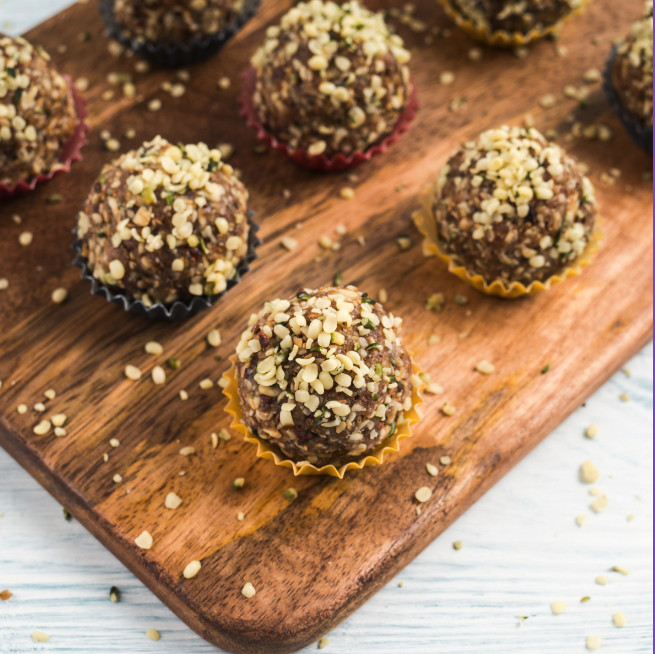
Indulge in a treat that's both delicious and nourishing with these adaptogenic, ayurvedic, and protein-packed energy bites. Packed with almonds, pumpkin seeds, and sunflower seeds, these bites provide a healthy dose of nutrients. They're sweetened with your choice of honey, maple syrup, or date syrup, according to your dosha type, ensuring a personalized touch to your snack.
The addition of tahini, ghee or coconut oil, and a blend of spices like cinnamon, ginger, and cardamom, together with ashwagandha and cacao powder, creates a flavorful and health-boosting combination. Simply blend the ingredients into a rough paste, form into balls, and optionally coat them in shredded coconut for added texture. Store your creations in the fridge or freezer to enjoy a cool, satisfying treat after your next workout session.
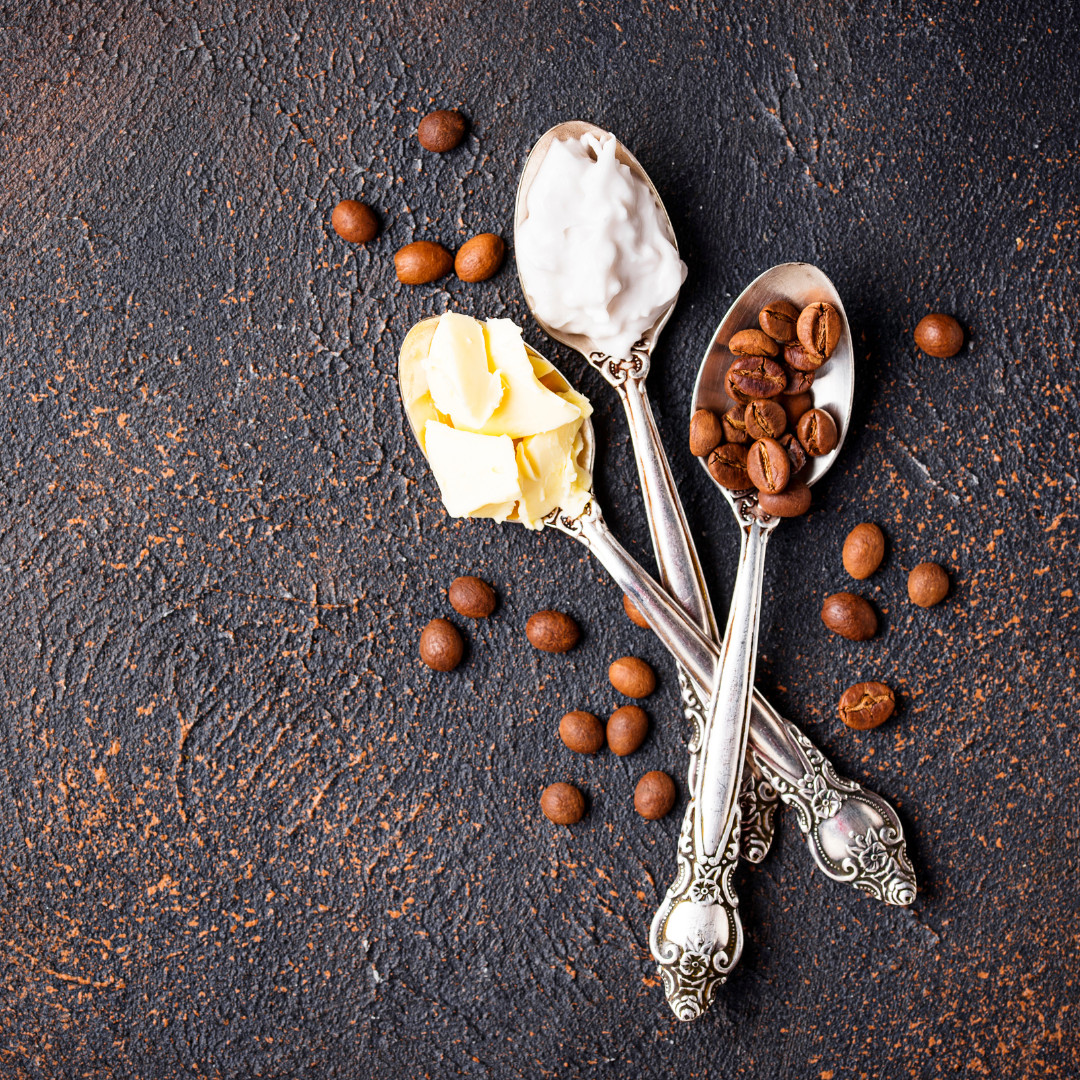
Enhance your coffee experience with an Ayurvedic twist that not only improves flavor but also mitigates the adverse effects associated with caffeine consumption. By incorporating grass-fed ghee, rich in vitamin A for adrenal and thyroid support, and coconut oil, which offers soothing, stable saturated fats, you can transform your coffee into a nourishing beverage that protects your stomach lining and nerves.
This Ayurvedic booster aligns perfectly with the energetic needs of Vata types, enabling them to enjoy coffee without over-stimulating their system. The blend of fats in this preparation helps "time-release" caffeine, providing a steady flow of energy without the typical caffeine crash. With roasted dandelion complementing the coffee's flavor while supporting the liver, this blend offers a holistic approach to coffee consumption.
Adding spices like cinnamon, cardamom, and rose lends a cooling effect to counterbalance coffee's natural heat, while adaptogens like ashwagandha and shatavari support adrenal health and the nervous system. This versatile concoction isn’t limited to just coffee; it's an ideal addition to tea, snacks, and even desserts, allowing you to enjoy its benefits across various dietary delights. Explore this innovative recipe to savor the complex flavor while nurturing your body.
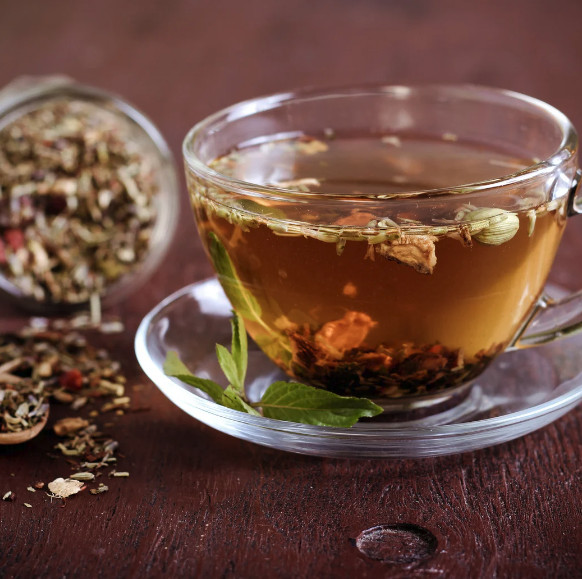
Ayurveda recognizes a 5-spice blend consisting of fennel, cumin, coriander, cardamom, and ginger as a powerful solution for digestive health. This blend addresses common issues such as gas, bloating, indigestion, and abdominal discomfort, helping to heal at the root rather than merely alleviating symptoms. These spices, deeply rooted in tradition, work gently yet effectively to enhance the body's natural digestive processes without creating dependency.
Each spice offers unique benefits: coriander cools the intestinal tract and supports enzyme production, cardamom makes dishes more digestible and reduces acidity, cumin acts as a potent tonic for digestive strength, fennel combats gas and supports lymphatic function, and ginger ignites digestive fire and balances the digestive system. Together, they increase bile flow, support enzymatic activity, and promote a healthy microbiome, while improving metabolism and encouraging optimal weight and elimination.
Incorporating these spices into one's diet through blends or teas can naturally reset digestive health, as emphasized in Ayurvedic consultations. Ayurveda suggests that proper digestion is foundational for overall health, believing that when the diet is correct, there is no need for medicine, but if the diet is wrong, medicine is ineffective. For those interested in exploring these natural remedies, consultations with experts like Seva Ayurveda can provide personalized guidance.











